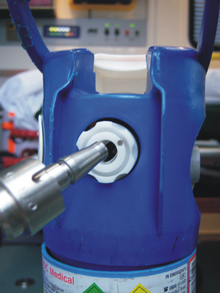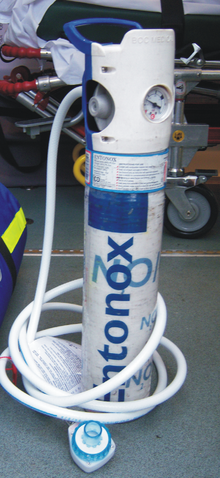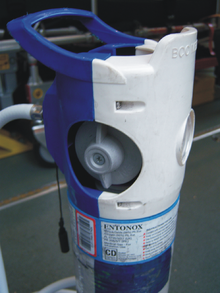- Nitrous oxide and oxygen
-
- Gas and air redirects here, for the 1923 film, see Gas and Air (film)
A mix of nitrous oxide 50% and oxygen 50% is a medical anaesthesia gas, commonly known as Entonox (a registered trademark of BOC) or Nitronox,[1] or colloquially as 'gas and air',[2] and is frequently used in pre-hospital care, childbirth and emergency medicine situations by medical professionals such as doctors, nurses, midwives and paramedics.[3]
Contents
History
Nitrous oxide as a single gas was first used as a medical analgesic in 1844 by American dentist Horace Wells, growing in popularity in the late 1800s.[4][5] Negative side effects were found from the hypoxia caused by a lack of oxygen, and the requirement to have at least 21% oxygen content in the gas was discovered (the same percentage as in air).[5]
In 1911, the anaesthetist Arthur Ernest Guedel first described the use of self-administration of a nitrous oxide and oxygen mix.
It was not until 1961 that the first paper was published by Michael Tunstall et al. describing the administration of a pre-mixed 50:50 nitrous oxide and oxygen mix, which led to the commercialisation of the product.[5]
Composition
 Typical Schrader valve attachment, making the gas usable only with demand based giving sets
Typical Schrader valve attachment, making the gas usable only with demand based giving sets
The gas is made of a mixture of fifty percent nitrous oxide (N2O or laughing gas) and fifty percent oxygen (O2).[1][3] The ability to combine nitrous oxide (nitrous oxide is the common name; dinitrogen monoxide, systematic name) and oxygen at high pressure while remaining in the gaseous form is due to the Poynting effect (after John Henry Poynting, an English physicist).[3]
The Poynting effect involves the dissolution of gaseous O2 when bubbled through liquid N2O, with vaporisation of the liquid to form a gaseous O2/N2O mixture.[3]
Inhalation of pure nitrous oxide over a continued period would render a human hypoxic,[6] and the 50% oxygen content prevents this from occurring. The two gases will separate at low temperatures (<4 °C), which would permit administration of hypoxic mixtures. Therefore, it is not given from a cold cylinder without being shaken (usually by cylinder inversion) to remix the gases.
Administration
The gas is self administered through a demand valve, using a mouthpiece, bite block or face mask.[1] Self-administration of Entonox remains safe because if enough is inhaled to start to induce anaesthesia, the patient becomes unable to hold the valve, and so will drop it and soon exhale the residual gas. This means, that unlike with other anesthetic gases, it does not require the presence of an anaesthetist for administration. The 50% oxygen in Entonox ensures the patient will have sufficient oxygen in their system for a short period of apnoea to be safe.
Action on the patient
Nitrous oxide is itself active (does not require any changes in the body to become active), and so has an onset in roughly the lung-brain circulation time. This gives it a peak action 30 seconds after the start of administration;[3] Entonox should thus be used accordingly, e.g. use should begin 30 seconds before a contraction becomes painful in labour. It is removed from the body unchanged via the lungs, and does not accumulate under normal conditions, explaining the rapid offset of around 60 seconds.[3]
Nitrous oxide is more soluble than oxygen and nitrogen, so will tend to diffuse into any air spaces within the body. This makes it dangerous to use in patients with pneumothorax or who have recently been scuba diving, and there are cautions over its use with any bowel obstruction.
Its analgesic effect is strong (equivalent to 15 mg of subcutaneous route morphine[3]) and characterised by rapid onset and offset (i.e. it is very fast-acting and wears off very quickly).
Contraindications and cautions
Nitrous oxide should not be used in patients with bowel obstruction, pneumothorax, middle ear or sinus disease,[3] and should also not be used on any patient who has been scuba diving within the preceding 24 hours[7] or in violently disturbed psychiatric patients.[1] There are also clinical cautions in place for the first 2 trimesters of pregnancy and in patients with decreased levels of consciousness.[3]
References
- ^ a b c d UK Ambulance Service Clinical Practice Guidelines. Joint Royal Colleges Ambulance Liaision Committee. 2006. ISBN 1-84690-060-3. http://www2.warwick.ac.uk/fac/med/research/hsri/emergencycare/prehospitalcare/jrcalcstakeholderwebsite/guidelines/clinical_guidelines_2006.pdf.
- ^ "Entonox (gas and air)". Baby Centre. http://www.babycentre.co.uk/pregnancy/labourandbirth/painrelief/entonox/.
- ^ a b c d e f g h i "Entonox". Anaesthesia UK. http://www.frca.co.uk/article.aspx?articleid=100364. Retrieved 2009-04-10.
- ^ Erving HW (1933). "The Discoverer of Anæsthesia: Dr. Horace Wells of Hartford". Yale Journal of Biology and Medicine, May 1933; v.5, n.5, p.421–430. http://ukpmc.ac.uk/picrender.cgi?artid=1703729&blobtype=pdf.
- ^ a b c "History of Entonox". BOC Gases. http://www.entonox.co.uk/en/discover_enotonox/story_and_heritage/index.shtml.
- ^ "Breathing Nitrous Oxide". Nitrous Oxide Supplies. http://www.nitrousoxidesupplies.co.uk/automotive/breathing.phtml.
- ^ Komesaroff, D (1998). "Oxygen administration in diving accidents.". South Pacific Underwater Medicine Society Journal 28 (3 Supplement). http://archive.rubicon-foundation.org/5974. Retrieved 2011-03-29.
External links
Wikimedia Foundation. 2010.


